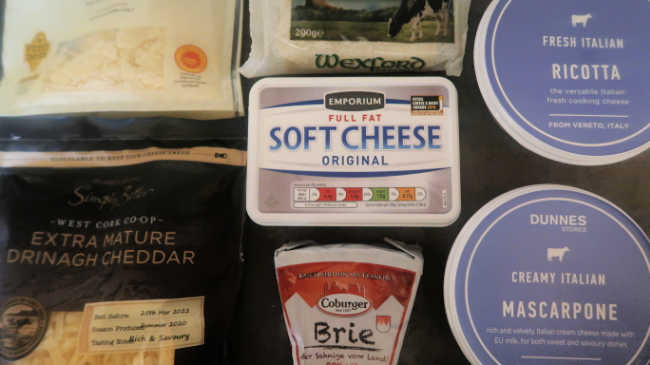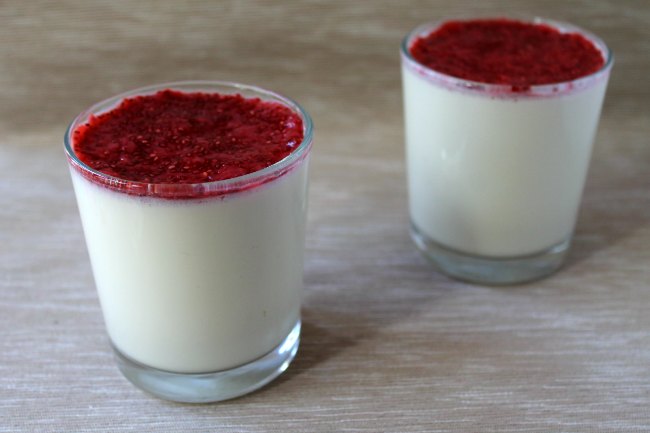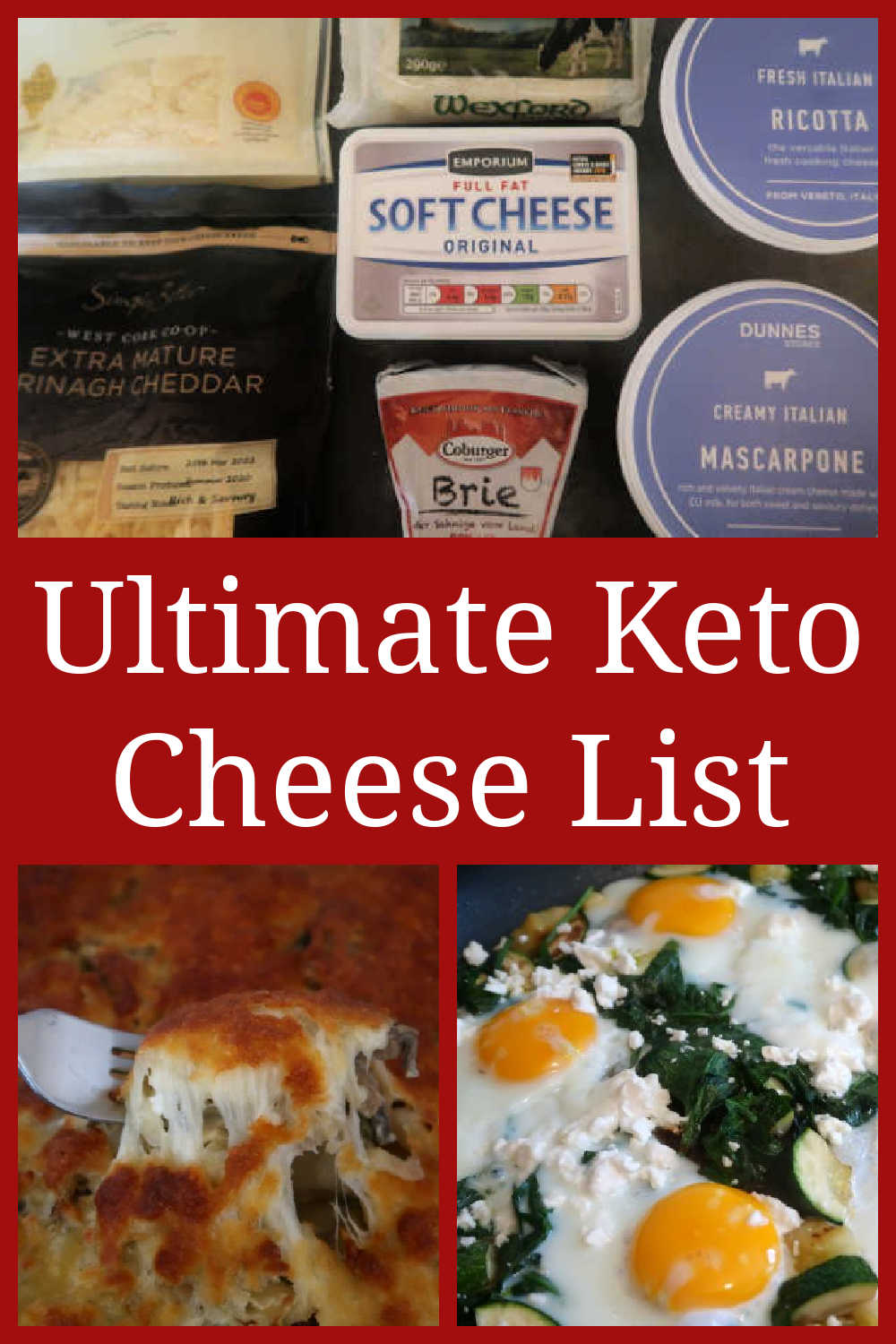Now love yourself and enjoy this one ...
Keto Cheese List – The ultimate guide of cheeses you can eat on a low carb and ketogenic diet – along with the best recipes to enjoy different types of dairy products.

Keto Cheese List
This keto cheese list outlines the best cheeses and easy ways to include them as part of a low-carb diet lifestyle to help you with weight loss.
You’ll find that keto-friendly cheese is low in net carbs, while having a healthy content of grams of fat and moderate protein, making them perfect to help maintain blood sugar levels instead of foods with higher carb counts. (Source.)
Hard Cheese

There’s a tasty choice of hard cheeses and semi-hard cheese to choose from, including cheddar cheese, Swiss cheese, American cheese, Romano cheese, Gruyere, Emmental and a host of others you’re likely to find at your local grocery store.
Make sure you pick a full-fat cheese option and check the ingredients list carefully when buying grated cheese, because starches and other carbs may be added to stop grated cheese from clumping together in the packaging.
Keto dieters can enjoy hard cheeses in meals that are low in grams of carbs like casserole, a cheesy keto omelette, salad or simply as a snack with almost zero carbs.
Parmesan

While Parmesan is certainly a hard cheese, I believe it deserves a category all on it’s own due to the complex flavor profile that can element any dish to gastronomic heights.
A simple bowl of spinach leaves or low-carb vegetables can be transformed with a sprinkling of Parmesan cheese and drizzle of olive oil like in a Parmesan salad recipe.
Cream Cheese

Now we’ve moved onto the creamy soft cheeses, starting with cream cheese that has a variety of sweet and savory uses.
Of course there’s creamy low carb cheesecake, and you could also make an easy lemon, strawberry or chocolate mousse infused with cream cheese.
Brie

Brie cheese makes an excellent choice for snacking or you can make garlic baked brie for an indulgent keto friendly appetizer.
Blue Cheese

Strong flavored blue cheese can add an interesting flavor profile to a steak salad, soup or as a sauce to enjoy with a low carb meal.
Ricotta and Cottage Cheese

Soft ricotta cheese and cottage cheese can be used as a spread or dip for cucumber or celery slices, in a breakfast scramble or in a sweet dessert like panna cotta, 3 ingredient chocolate mousse or cake.
Goats Cheese

You can enjoy goat cheese made with goat’s milk or sheep cheese varieties made with sheep’s milk in a host of sweet and savory dishes.
With cheesecake and salad being some of my favorite ways to enjoy the semi-soft cheese.
Feta Cheese

Flavorful feta cheese can be chopped or crumbled over salad, soup or a big breakfast shakshuka.
Mascarpone Cheese

Indulgent, creamy mascarpone cheese can be blended with heavy cream to make a light dessert like chocolate mousse or panna cotta, or used to make a creamy, cheesy sauce to enjoy with zucchini noodles.

Best Keto Cheese Video
Here’s the video where I talk you through some of my go to low carb cheese favorites. Hit play below or click here to watch on YouTube.
More Low Carb Diet Inspiration
7 Day Keto ALDI Meal Plan
20 Quick Keto Breakfast Ideas
How To Do Lazy Keto
Keto-friendly Foods List
Disclaimer – this post is meant for informational post only and should not be construed as medical advice. Please consult with your health professional before making any dietary changes.
Disclosure – this post contains affiliate links.
The post Keto Cheese List appeared first on Yummy Inspirations.
By: Jolene @ Yummy InspirationsTitle: Keto Cheese List
Sourced From: yummyinspirations.net/2022/01/keto-cheese-list/
Published Date: Sun, 23 Jan 2022 13:50:30 +0000
Frequently Asked Questions
Is organic food healthy?
There are two types of foods; those we grow ourselves and those we buy from someone else. Although there are exceptions to each category, most of the answers to your question are yes. Organic food is healthier than conventional food because it doesn’t contain harmful chemicals, pesticides or herbicides. It also doesn’t contain preservatives or genetically modified organisms.
You can find organic food in supermarkets across North America, Europe, Asia, Latin America, and Africa. Many grocery stores now sell organic food. This makes it easier for customers to select organic products.
Organic food is healthier and tastes better because it contains more vitamins, minerals, antioxidants, and other nutrients. Organics are grown without using pesticides and fertilizers. They also don't pollute soil or water.
Organic farming is regulated by the USDA. Farmers must follow strict guidelines to ensure safe eating. There are currently over 30 million acres of US farmland certified as organic.
Organic food can often be cheaper than conventional food. Customers pay less for the same amount in calories, protein and nutrients. Organic farms are free to charge less for their crops, as they don't need to pay expensive chemical inputs such insecticides orfungicides.
According to the Environmental Working Group Organic food is actually 10 percent more expensive per pound than conventionally grown food. If you care about the health of yourself and your family, consider switching to organic food.
Organic food has become a popular alternative to standard American diets. Organic food is not only available in gourmet restaurants and specialty markets, as many people may believe. You can easily purchase organic food in regular grocery stores throughout the United States.
The sales of organic food have increased dramatically in recent years. Organic food market value in the US increased from $21 billion to $43 billion in 2007 to reach $43 billion in 2012.
Organic meat is better
If you've been paying attention for any time, you probably already know the answer to this question. This is the crux of it: organic food has been growing in popularity while conventional food has fallen out of favor.
Organic foods continue to be popular because they offer a healthier alternative. Organic foods are safer for our bodies and help to reduce pollution.
There are two sides to the coin. Organic produce takes longer to grow, and it requires more resources. Organic food can be more expensive than its nonorganic counterpart.
Organic meats tend to be more expensive than those raised conventionally. But, you can reduce the cost of organic meats without compromising quality.
Locally grown produce is a great way to save money. Locally grown fruits and veggies help to lower prices because farmers get incentives to grow good crops.
Look for bargains to cut down on costs. There are often discounts offered when purchasing organics.
You can also save money by eating less meat. Because of the amount of feed required to raise livestock, meat production can become expensive.
There are many reasons that organic food is better than regular food for our bodies, and also for the planet. However, it is important to remember the price.
What is inorganic foods?
Organic food is not produced with pesticides or artificial fertilizers. These chemicals can be harmful for your health.
Organic food can be grown without chemical fertilizers, pesticides herbicides, fungicides, and other harmful substances. These chemicals can be dangerous for both humans and animals.
Inorganic foods are meats, fishes, eggs, buttermilk, cheese, yogurt and honey as well as vegetables, fruits and spices.
The way that an agricultural product is grown organically is what the term means. Organic farming is based on natural methods, soil amendments, and crop growth. Conventional farming uses pesticides, fertilizers, and chemicals.
U.S. Department of Agriculture guidelines must be followed when organic food is labeled. According to the National Organic Program Standards all organic food must be free of banned materials such as antibiotics growth hormones genetically modified organisms GMOs, and industrial solvents. Organic food must not be produced with toxic chemicals, petroleum or sewage sludges or ionizing radioactive substances.
Why should organic be my first choice?
Many health issues have been linked to conventional agriculture, including obesity, diabetes and cancer. You must make healthy choices when buying food.
The Environmental Working Group has the following tips for choosing "cleaner" food.
When possible, buy organic fruits and veggies
USDA organic labels can be found on meat, poultry (eggs, eggs), milk, cheese and yogurt as well.
Avoid processed foods that claim to be "natural" and "no additives."
Check ingredient lists carefully. If an ingredient is not listed, it can be added during processing.
Choose fresh meats over frozen or canned ones. Foods that are frozen or canned often have less nutritionally-rich ingredients, such as high fructosecorn syrup.
What is organic meat exactly?
Organic meat is food that has not been treated with pesticides or artificial fertilizers. Organic meat is also a guarantee that the animals weren’t fed any genetically altered feed. It is safe to eat because it doesn't contain any harmful chemicals.
Organic meats are also better for our environment. Eating organic foods helps reduce pollution in the environment, such as rivers and lakes. Organic farmers are less likely to use toxic chemicals to kill birds or insects. This helps protect wildlife.
It is best to buy organic meats locally as much as possible. Local buying helps to keep money in the community, rather than moving out of state. Local businesses often pass on savings to customers shopping locally. Shopping locally keeps American jobs in America, rather than sending them abroad.
What are the most popular organic products?
Today organic food is the fastest-growing sector. But even though we've come a long way from our roots, there is still much room for growth.
Organic products are the future. They are safer, healthier for the environment, and easier to afford for consumers.
However, they are also more expensive. The Organic Food Index was created to address this. We wanted to find out which foods are most popular with shoppers today, and whether these trends are changing.
The results show that organic food is becoming increasingly popular. Between 2011-2012, nearly half of Americans shopped for organic foods.
According to USDA, organic production grew by 10% last year. Organic food now makes up 9% U.S. agriculture output.
While organic food is certainly gaining ground, it seems that it is still an expensive choice for consumers. According to the Organic Trade Association OTA, organic food retail prices are about twice those of conventional products.
Despite this, organic food is growing at a faster rate than any other food segment. If you look closely at the data, it will be apparent that organic food consumption has steadily increased since 2009.
According to OTA the volume of organic products sold at supermarkets grew by 14% in 2010 and 2011.
This is because consumers are looking for healthier foods. Organic food sales have been increasing in all age groups.
Younger generations are choosing organic food more often than older generations. Millennials are twice as likely than baby boomers to buy organic foods. Young adults below 35 years of age account for 25%.
Statistics
- Popular clothing brands, like Patagonia, are labelled as organic by using 100 percent organic cotton for many of their styles. (en.wikipedia.org)
- Cosmetic brands such as Laurel and Rose Mira are 100 percent organic and have a wide array of skincare products. (en.wikipedia.org)
- To provide the highest quality products and services to every customer, with a dedicated workforce that puts the customer first and takes the extra step to achieve 100% customer satisfaction and loyalty. (hollinsorganic.com)
- Nutrients like omega-3 fatty acids were up to 50 percent higher in organic meats and milk than in conventionally raised products.[3] (en.wikipedia.org)
External Links
ewg.org
ncbi.nlm.nih.gov
- PubMed: Evaluation of the micronutrient content of plant foods grown using conventional and organic agricultural methods.
- Comparison of the total phenolic and ascorbic acid content of freeze-dried and air-dried marionberry, strawberry, and corn grown using conventional, organic, and sustainable agricultural practices - PubMed
sciencedirect.com
- Organic food and the impact on human nutrition: A comparison of the status-quo and potential research - ScienceDirect
- Technical note: Simultaneous Vitamin and Carotenoid Analysis of Milk from Total Mixed Ratio-Fed Cows - ScienceDirect
ota.com
How To
Organic food: Are they healthier and better for you?
Organic foods are grown without the use chemical pesticides or synthetic fertilisers. They are grown naturally without artificial inputs such pesticides and herbicides. Crop rotation, cover crops and the use of compost animal manure, wastewater recycling, and integrated pest management (IPM) are some examples of organic farming.
The USDA National Organic Program (NOP) was established in 2002 to regulate the production, handling, processing, labelling, sale, and distribution of organic products sold in the United States. Organic agricultural products must be produced in accordance with federal standards as set out by the Federal Food, Drug, and Cosmetic Act. Additionally, organic products must not contain prohibited substances like pesticide residues or genetically modified organisms.
For producers in the USA who want their products "organic", there are two kinds of certification programs: one for farmers or ranchers and one for manufacturers. Both programs require an annual audit of the operations in order to confirm compliance with stringent standards. These services are offered by several certifying agencies, including CCOF Certified Organic Farmers & Ranchers and Quality Assurance International. These three organizations provide third party verification of farms following strict guidelines on environmental stewardship. labour practices, and animal care.
According to USDA's Economic Research Service (ERS), organic agriculture accounted in 2013 for $4.7 Billion in sales. That year, retail spending on certified organic products totalled nearly $1.5 billion, representing a 23 percent increase since 2009. Groceries sales increased by 12 per cent during this time. Spending on direct purchases of organic produce increased by 29 percent, while spending on meat, poultry, eggs, dairy, and seafood grew by only 1 percent.
Organic food is more expensive, but consumers believe its quality is worth the extra cost. Consumer Reports conducted a 2015 survey and found that 88% would pay more if organic food had better nutritional value. Health Affairs also reported that organic food intake is associated with fewer health problems, such as obesity, diabetes and heart disease.
While there is no evidence that organic food can prevent or treat any diseases, there are some studies suggesting that eating them may improve your overall health by reducing your exposure to pesticides and other contaminants. In 2010, a review that included 31 studies concluded that organically-raised beef had lower levels of parasites and toxic chemicals than conventionally reared beef. Similar results were also reached by a separate analysis of 11 2012 studies.
A 2014 report from the Environmental Working Group looked at data from the Department of Agriculture's Agricultural Marketing Resource Center and found that the incidence of foodborne illness caused by E. coli, salmonella, listeria monocytogenes, campylobacter, and verotoxin-producing E. coli O157:H7 decreased when comparing organic to non-organic chicken, pork, beef, lamb, milk, and cheese. The group also observed that E.coliO157 is a less prevalent cause of illness in humans among children than adults. This was because the USDA has imposed stricter organic standards on animals raised for human consumption.
Did you miss our previous article...
https://belovedsaffron.com/recipes/cauliflower-tacos
.png)





